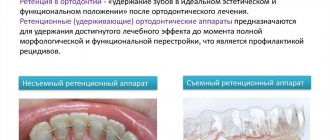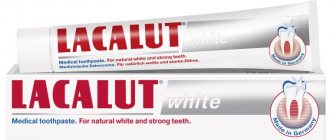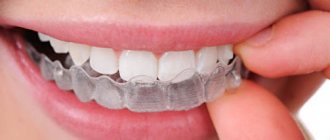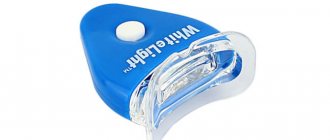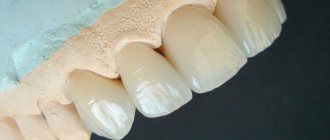The teeth whitening procedure allows you to return the enamel to its original color and make your smile as aesthetically pleasing as possible. However, you need to remember that you cannot limit yourself to the procedure in the dentist’s office - in the first time after it is carried out (about 5-10 days), it is important for the patient to maintain and consolidate the achieved result. Restoring teeth after whitening and preserving the resulting enamel color is the patient’s main concern during this period.
Why do teeth darken after whitening?
The following factors influence the change in color and tone of tooth enamel after the procedure:
- external staining (in fact, it is a colored plaque on the teeth);
- penetration of coloring substances deep into the enamel through existing microspaces;
- smoking;
- taking certain medications (for example, iron supplements) or rinsing the mouth with coloring solutions (for example, hydrogen peroxide);
- poor oral hygiene [1].
How does whitening work?
We use several systems that differ slightly in the technique of implementation and the composition of the whitening gel. How whitening occurs and how long the procedure takes depends on the chosen system.
For example, the latest development, Philips Zoom QuickPro, is the fastest procedure that does not require exposure to light. The doctor only needs to apply a gel to the enamel, which the patient must wipe off with a napkin or toothbrush after half an hour.
Another well-known lampless system is Opalescence. We also offer teeth whitening using Zoom or Klox technologies, where each stage of applying the gel is fixed with lamp light.
Any of these methods takes no more than an hour and does not involve a recovery period. You just need to avoid eating and drinking for 2-3 hours after the procedure.
Actions to maintain whitening results
After visiting the dentist's office, the work on the beauty of your smile does not end. The recommendations of the attending physician, as well as general standards of oral hygiene, should be followed.
- Brush your teeth daily with a suitable toothbrush.
- Use toothpaste without coloring ingredients.
- Choose a toothpaste that will strengthen the enamel layer and reduce sensitivity (such products contain fluoride compounds - aminofluoride, sodium fluoride or hydroxyapatite).
- Follow a “white” diet.
- Use floss to clean interdental spaces.
- Avoid decorative cosmetics for several days to avoid staining your teeth pinkish-red (lipstick, lip gloss).
The effect of teeth whitening lasts on average six months.
Everyone has a unique dentin color and enamel thickness, so the results will vary. A patient cannot be guaranteed a certain tooth color. It is important to remember that the result does not depend on the drug or the doctor, but rather on the individual characteristics of the body. Akhutina K.K., chief physician of the Allegro dental clinic (two years in a row included in the list of the 100 best private dental clinics in Russia and in the top ten best clinics in St. Petersburg according to the Kommersant Publishing House) [2]
Features such as the natural yellow or grayish tint of the enamel can be changed slightly. In this same situation, careful oral hygiene and good habits can play a decisive role and prolong the whitening effect.
Does teeth whitening hurt?
The teeth whitening procedure itself in Krasnoyarsk is carried out with comfort. The patient does not feel pain or any discomfort. This is not a treatment where the doctor acts on the tooth tissue. Here you just need to apply a special gel to the enamel and dry it under the light of a lamp or simply leave it for a while.
After the procedure, a short-term increase in sensitivity is possible, which will pass very soon.
If you can't decide whether to have teeth whitening, schedule a consultation. The doctor will answer all questions and advise the best way to improve the aesthetics of your smile. Please note that the procedure has contraindications. In addition, the doctor can immediately understand in which cases teeth whitening will not work - they will immediately warn you about this. There are alternative ways to influence the shade of the enamel, such as veneers, whitening pencils, strips or trays.
Each patient has his own parameters and characteristics - that’s why we always talk about the importance of consultation before teeth whitening and other procedures. Any materials on the Internet may be used for informational purposes only.
Products hazardous to tooth color
Some products have the ability to color surfaces upon contact, especially porous tooth enamel, due to the presence of their own pigments:
- Black tea;
- cocoa;
- coffee;
- bright sauces (soy, curry, ketchup, etc.);
- colored fruits, including citrus fruits;
- vegetable and fruit juices;
- fruit drinks and compotes;
- carbonated drinks with dyes;
- chocolate;
- berries and jam;
- egg yolks;
- alcohol (red wine).
In the first two weeks, it is especially important to adhere to strict restrictions and recommendations of the dentist. After bleaching, the micropores open and absorb dyes faster. You need to exclude colored foods from your diet at least for the first time.
Whitening principle
At the moment, there are two types of whitening - office (professional) and home. Both methods are actively used to improve the color of teeth, but professional whitening is more effective. On the other hand, any type of whitening is based on the same principles. The basis of the bleaching agent is hydrogen peroxide or carbamide. When decomposed, free radicals are released, namely atomic oxygen, which effectively destroys dyes and pigments that accumulate in dentin. The effectiveness of whitening depends on a number of factors, including the concentration of the active substance and the regularity of the procedure.
What can you eat after teeth whitening?
The post-bleaching diet includes foods high in fluoride, calcium and phosphorus, vitamins C, A and E, and those that do not have bright colors [3, 4]:
- white meat;
- white fish;
- eggs (whites only);
- cereals (rice, pearl barley, oatmeal);
- white beans;
- soft and mild cheese;
- milk (fermented milk products are allowed only after 2-3 days, including yogurt without dyes);
- butter;
- vegetable oil;
- mushrooms with light flesh (white, champignons);
- potato;
- light vegetables (peeled cucumbers, white bell peppers);
- pasta;
- boiled or steamed cabbage;
- white or clear drinks.
Food should be warm or cool - nothing icy or scalding.
How to keep your teeth white for a long time
The darker a person's skin tone, the whiter their smile appears. It is this fact that explains why the teeth of dark-skinned people appear snow-white to others. We must admit that the natural white color of the dentition is a real gift from nature. However, it is known that only 5% of the world's population have such an impeccable shade of enamel. The rest will have to work hard to get white teeth. To do this, you can use modern methods of care and whitening.
Important! Even after resorting to professional help, it is necessary to maintain the results obtained at home for as long as possible.
What is the secret to keeping your teeth white?
Natural whiteness is an integral component of organ health. To achieve this, you need to:
- promptly treat caries of the entire oral cavity;
- carry out high-quality filling;
- care for and strengthen teeth;
- polish tooth enamel, etc.
If your mouth is healthy, all that remains is to freshen your breath and give your snow-white smile a dazzling, flawless look. Fortunately, the technical equipment and professionals of Crystal Dentistry provide the highest level of service.
Tooth enamel is considered the hardest tissue in the body. It provides thorough chewing and gnawing, and when consuming food or drinks, it exhibits a certain resistance to hot or cold temperatures. However, teeth are located in the oral cavity, they are surrounded by mucous membranes, which are “populated” by millions of bacteria. Daily brushing of teeth at least 2 times a day is a salvation against an army of such “pests”.
Factors that have a detrimental effect on enamel are:
- eating sweet foods that leave plaque on the teeth;
- presence of bad habits (smoking, alcohol);
- frequent consumption of strong drinks (coffee, cocoa, tea);
- fast food abuse;
- frequent consumption of foods high in dyes and preservatives.
If the patient cares about a beautiful smile, the food consumed should be controlled, and oral care should be more thorough.
Features of daily care after whitening
Procedures can be divided into two groups:
- Cleansing teeth and root of tongue from plaque.
Studies show that within 4–6 hours after the “work” of the toothbrush, a soft layer is deposited on the surface of the tooth. If the problem is ignored, it quickly accumulates and turns into a dense coating. The color of teeth becomes dull and deteriorates, since toxins, acids, and potential causative agents of infections and inflammations released by microorganisms are considered the most likely causes of the loss of the healthy appearance of teeth. - Restoring enamel using special toothpastes.
The structure of a healthy organ is 95% composed of strong calcium and phosphorus mineral complexes. The rest is occupied by organic matter and water. In a healthy state, processes of remineralization and demineralization of enamel occur on the surface of the tooth. They are in relative balance. During remineralization, Ca penetrates from food into saliva and then saturates the structure of the surface layers of enamel. During demineralization, acids and bacteria “isolate” the mineral from the surface of the tooth, destroying it. If there is no constant care and cleaning, the latter process begins to prevail, and the tooth enamel loses its structure and changes color.
How to maintain whiteness for a long time after bleaching
It is important to remember not only the quantity, but also the quality of cleaning. Teeth care after whitening should be more thorough. Yellow, soft deposits can be easily removed by regular cleaning, choosing a brush with medium-hard bristles. The procedure should take place within 3 minutes. Dental floss should be used between rows. Don't forget about the rinse aid. If the accumulated deposits cannot be removed on your own, you can resort to professional cleaning and removal of tartar in the clinic.
After the whitening procedure, it is recommended to carry out a course of restorative measures lasting about 1 month. How to keep teeth white for a long time without good restoration? It is advisable to choose toothpaste with sufficient fluoride or calcium compounds. They help strengthen the structure of tooth enamel.
What is the “white diet”
After whitening, the doctor will definitely talk with you and give effective recommendations on how to keep your teeth white for a long time. Among these methods is eating colorless food. The “White Diet” is a list of products that, after lightening, will make up a person’s daily diet. Often, a specialist recommends sticking to it for several weeks after the whitening procedure. The list of selected products includes:
- white meat fish, stewed or baked chicken;
- potatoes, cabbage;
- White mushrooms;
- rice, soy;
- milk, fermented milk products, tofu cheese;
- green apples, pears;
- walnuts;
- wheat bread.
With this diet, the consumption of coloring “irritants” should be avoided. To maintain white teeth, you should exclude: bright vegetables, fruits, red wine, desserts, carbonated drinks, chocolate, artificial sweets, sauces, spices, smoked meats, “quick” soups.
What foods prolong the health and whiteness of teeth?
Strong enamel is the key to a beautiful smile. A proven way to keep it white and healthy is to eat healthy foods. This list includes:
- fresh solid vegetables and fruits (carrots, cabbage, broccoli, apples);
- dairy products rich in calcium (hard cheese, feta cheese, cottage cheese);
- nuts, white and black sesame;
- fresh juices (when consumed through a straw).
Don’t forget about special chewing gums without dye. It is necessary to limit the consumption of sugar-containing products to a minimum.
Sample menu for the week
Smile-safe food plan for the first weeks after whitening [3]:
| Days | Breakfast | Snack | Dinner | Dinner |
| 1st and 4th | Oatmeal with milk, cottage cheese, raisins, fermented baked milk. | Yogurt, banana. | Two boiled eggs, green tea with milk, cottage cheese with sour cream. | Cookies, yogurt. |
| 2nd and 5th | Rice porridge with honey, yogurt. | Sandwiches with butter and cheese, yogurt. | Mushroom cheese soup, steamed white meat with vegetables. | Banana, yogurt. |
| 3rd and 6th | Vermicelli porridge with milk, cottage cheese. | A handful of nuts, two boiled eggs. | Noodle soup, boiled potatoes with chicken. | Ryazhenka. |
| 7th | Semolina porridge with milk and butter. | White grapes, peach, peeled apples. | Boiled or baked fish with a side dish of steamed cauliflower. | Salad of peeled cucumbers or light, non-acidic fruits. |
List of sources:
- Burak J. Why teeth darken and how to restore their whiteness, portal “Healthy People” (24health.by), 2022 // URL: https://health.tut.by/news/disease/692875.html (access date: 02.11.2020).
- 10 facts about teeth whitening. Doctor's opinion. ONDOC, 2022 // URL: https://ondoc.me/blog/posts/9 (access date: 12/01/2020).
- Bolotina T.A. White diet after teeth whitening. Blog of practicing dentists DentConsult, 2022 // URL: https://dentconsult.ru/otbelivanie-i-chistka/belaya-dieta-posle-otbelivaniya-zubov.html (date of access: 02.11.2020).
- Vovilyuk A.L. Diet after teeth whitening. Dental portal “Anatomy of teeth”, 2005 // URL: https://yandex.ru/turbo/anzub.ru/s/esteticheskaya-stomatologiya/dieta-posle-otbelivaniya-zubov/ (date of access: 02.11.2020) .





